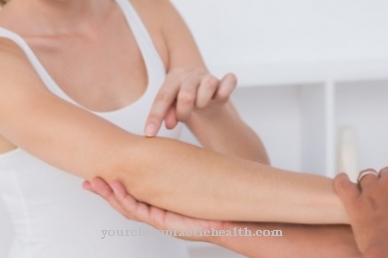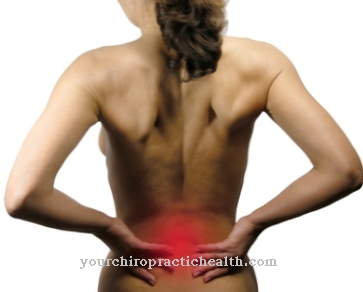Rash on chin usually occurs as a symptom of perioral dermatitis. It is a harmless skin condition that can trigger inadequate or excessive skin care regimen. Reducing the use of cosmetic and skin care products helps heal chin rashes.
What is a chin rash?

A rash on the chin describes a condition in which vesicles a few millimeters in size, small nodules and reddened skin appear on the chin. Some people have dandruff.
The rash often spreads like a ring so that it spreads to the region around the mouth, cheeks and nose. It is characteristic that the rash leaves a narrow border around the lips. In rare cases, the rash spreads to the eyelids and forehead. The so-called perioral dermatitis triggers a feeling of tension in the affected areas. The skin burns and itches.
The symptoms increase under the influence of hormonal fluctuations, UV light and mechanical stimuli such as those caused by cleaning procedures. The vernacular describes the skin disease as rose mouth or stewardess disease. A rash on the chin is not dangerous.
causes
What causes the rash on the chin is unknown. However, medical professionals suspect that excessive and / or incorrect skin care can cause irritation to the skin, which can lead to perioral dermatitis. This is often the case if the person concerned has sensitive skin that is susceptible to allergies.
Inadequate or excessive skin care causes the skin to lose its ability to retain fluid. As a result, the skin dries out and tends to form flakes. Pathogens can attack the skin more easily, which leads to infections. If the person concerned reacts with an additional intensification of skin care, it worsens the rash on the chin.
The rose in the mouth is the most common cause of the rash on the chin. Other causes can be a heat rash, cradle cap, certain childhood diseases such as measles and chickenpox, side effects to medication, neurodermatitis, acne, a contact allergy or rosacea.
What these causes have in common, however, is that they not only trigger a rash on the chin. They cause additional rashes on other parts of the body. Perioral dermatitis is limited to a rash on the chin and surrounding areas.
You can find your medication here
➔ Medicines for rash & eczemaDiseases with this symptom
- Oral rose
- acne
- Rosacea (rosacea)
- Cradle cap
- Neurodermatitis
- rubella
- measles
- chickenpox
- Ringlet rubella
Diagnosis & course
Home remedies ↵ for rash A doctor will often diagnose the rash on the chin as a rose in the mouth by looking at the affected areas of the skin. The pattern in which the rash spreads on the chin and around the mouth and the recessed area around the lips suggest perioral dermatitis.
To confirm the diagnosis, he asks the person about their skin care habits. In this way, he can assess whether incorrect or excessive skin care has contributed to the development of the rash on the chin. Oral rose usually heals within a few weeks after therapy has started without leaving any scars.
If other diseases are suspected, such as acne, neurodermatitis, contact allergy or rosacea, the doctor will carry out blood tests. He examines skin areas all over the body to rule out perioral dermatitis. He may also take skin samples in order to be able to make an accurate diagnosis.
Complications
A rash on the chin is a completely harmless disorder of the skin, usually it is caused by "over-feeding" the skin. The cosmetic and skin care products should be reduced as much as possible, this will significantly aid healing.
A rash on the chin is still unpleasant, blisters and reddening of the skin may appear. The rash often spreads like a ring on the chin, so that it can affect the area around the mouth, nose and cheeks. The skin burns or itches and there is a feeling of tension. The rash on the chin is completely harmless, if the cleaning procedures are stopped or reduced, the rash will go away by itself.
Where the chin rash actually came from is pretty much unknown, but improper skin care routine is definitely responsible. Excessive skin care is downright criminal, especially for sensitive skin, because it loses its actual function, namely to store fluid. This allows the pathogens to easily penetrate the skin, which in turn leads to the reactions. Of course, "childhood diseases" can also cause a rash on the chin and side effects of certain medications cannot be ruled out. However, sometimes it's an allergy or an itchy sweater. Usually the rash on the chin is completely harmless, but if the doctor finds acne or neurodermatitis, the patient is treated for these diseases. A blood count brings clarity.
When should you go to the doctor?
A rash on the chin is often the result of excessive skin care. One can certainly speak of taking care of the skin here. This phenomenon is also known as stewardess disease. It can therefore already help to reduce the arsenal of skin care and cosmetic items.
Tiny vesicles, nodules and reddening of the skin are typical of a rash on the chin. Occasionally, flaking of the skin is observed. If you have a rash on your chin, there is a risk that it will spread further down your face. The burning and itching of the tight skin is uncomfortable. It makes perfect sense to see a doctor if you have a rash on your chin.
The family doctor is a suitable contact person to analyze the cause. In addition to the possible triggers mentioned, he can consider whether, in addition to a general skin irritation, there may be an allergy to certain substances, hormone fluctuations leading to this or whether it is acne. A rash on the chin can also be related to neurodermatitis. Children’s diseases such as chickenpox or measles should also be considered.
Occasionally, drug side effects also result in a rash. Depending on the findings, the family doctor will treat the rash himself or refer it to a specialist colleague such as an internist, dermatologist, allergist, gynecologist or pediatrician.
Doctors & therapists in your area
Treatment & Therapy
Since the exact causes of the rash on the chin are unknown, the therapy is individual.
First of all, the doctor performs zero therapy. As a result, the skin gets used again to taking up its functions independently. Over a period of several weeks, the person concerned refrains from any form of skin care products. Ointments containing cortisone should be avoided as well as washing lotions, cosmetics and skin creams. Zero therapy leads to an initial aggravation before the rash on the chin heals.
If the affected skin areas are severely inflamed, a doctor may prescribe medicinal products for skin care and medication. If perioral dermatitis occurs in connection with a bacterial infection, the doctor will give the person antibiotics in the form of ointments and / or tablets.
For other conditions, such as eczema and acne, a doctor will usually prescribe medications and ointments to treat the rash. This includes adequate basic skin care and anti-inflammatory measures. In the case of contact allergies, an attempt is made to determine the triggering allergen so that the person affected can avoid it in the future. Desensitization is a suitable measure to get the immune system of the person affected back used to the allergenic substance step by step.
Outlook & forecast
In many cases, a rash on the chin does not require special treatment. Very often this rash appears only temporarily and goes away on its own. This often leads to allergic reactions or intolerance. The rash on the chin will then go away again when the substance has been completely broken down in the body. This can take several days.
In some cases, the rash on the chin also appears due to poor hygiene. Frequent washing and the use of creams and conditioners for the face help here. However, if the rash on the chin occurs for a long time and is also associated with pain, a doctor should be consulted. It may be an intolerance or allergy that has not yet been recognized. The patient should then do without the respective food.
In most cases, the treatment takes place with the help of medication and can last up to several weeks. However, it usually leads to success, only very rarely does the rash remain on the chin for a long period of time.
The rash on the chin can greatly reduce the quality of life. There is often a feeling of shame. A doctor should therefore always be called in the event of pain and persistent rashes.
You can find your medication here
➔ Medicines for rash & eczemaprevention
To prevent a rash on the chin, a dermatologist recommends determining the skin type. The daily care should then be adapted to the respective skin type. In general, minimal use or the complete avoidance of cosmetics has a preventive effect. After the rash on the chin has been cured, the person affected should not resume their usual skin care routine, but rather work with a doctor to find out the optimal, individually tailored care.
You can do that yourself
What self-help measures are indicated for a rash on the chin depends on the causes. If the rash is the result of a food intolerance, the person affected should consistently avoid all suspicious foods until the symptoms have subsided. As a precaution, high-proof alcohol and nicotine should also be avoided. Such skin changes can be covered with make-up.
If the rash is the result of a contact allergy, the affected skin area should only be cared for with cosmetics that are marked as hypoallergenic. If there is a so-called rose in the mouth (perioral dermatitis), one thing applies above all: do not scratch. The nodes and vesicles typical for the clinical picture must not be opened under any circumstances.
A connection between perioral dermatitis and permanent stress is suspected. Affected patients should therefore learn relaxation practices and avoid stressful situations as much as possible for the duration of the illness. It is also important to ensure that your digestion is regulated, and a high-fiber, plant-based diet contributes to this.
Self-treatment with cortisone ointments is not advisable, as this usually only worsens the rose in the mouth in the medium term. In no case should the affected areas of skin be treated with any preparations other than those prescribed by the dermatologist. If the rose in the mouth is to be concealed with the help of decorative cosmetics, the attending physician must be consulted beforehand.





.jpg)





















